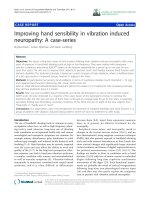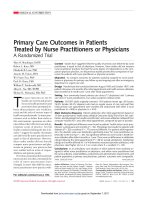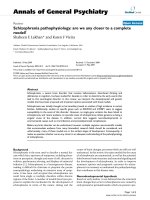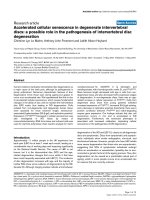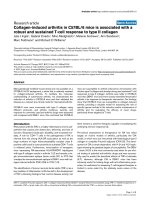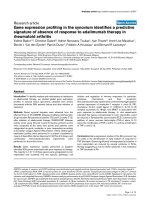Báo cáo y học: "Different fetal-neonatal outcomes in siblings born to a mother with Graves-Basedow disease after total thyroidectomy: a case series" doc
Bạn đang xem bản rút gọn của tài liệu. Xem và tải ngay bản đầy đủ của tài liệu tại đây (411.94 KB, 4 trang )
CAS E REP O R T Open Access
Different fetal-neonatal outcomes in siblings born
to a mother with Graves-Basedow disease after
total thyroidectomy: a case series
Antonio Alberto Zuppa
*
, Paola Sindico, Sabrina Perrone, Chiara Carducci, Eleonora Antichi, Giovanni Alighieri,
Francesco Cota, Patrizia Papacci, Maria Pia De Carolis, Costantino Romagnoli, Valentina Cardiello
Abstract
Introduction: We describe three different fetal or neonatal outcomes in the offspring of a mother who had
persistent circulating thyrotropin receptor antibodies despite having undergone a total thyroidectomy several years
before.
Case presentation: The three different outcomes were an intrauterine death, a mild and transient fetal and
neonatal hyperthyroidism and a severe fetal and neonatal hyperthyroidism that required specific therapy.
Conclusions: The three cases are interesting because of the different outcomes, the absence of a direct correlation
between thyrotropin receptor antibody levels and clinical signs, and the persistence of thyrotropin receptor
antibodies several years after a total thyroidectomy.
Introduction
Hyperthyroidism occurs in 0.05 to 0.2% of pregnancies.
In about 95% of cases it is due to Graves-Basedow dis-
ease. In can also be due to Hashimoto’ s thyroiditis or,
less frequently, to toxic adenoma, multinodular toxic
goiter, subacute or silent thyroiditis, hydatidiform mole
or choriocarcinoma [1-3].
Neonatal hyperthyroidism develops in about 1 to 2%
of babies born to mothers suffering from Graves-Base-
dow disease or, in a few cases, from Hashimoto’s thyroi-
ditis [4]. Neonata l hyperthyroidism is usually a transient
disorder. It rarely appears at birth, it is more usual
within the first week of life. Sometimes it can be lethal
because of the development of heart failure [3]. It is
usually caused by IgG antibodies stimulating the thyroid
stimulating hormone (TSH) receptors of the thyroid
gland, which are called thyrotropin receptor ant ibodies
(TRAb). TRAb are able to cross the placental filter and
stimulate fetal and neonatal thyroid function [5,6].
These antibodies can persist several years after
thyroidectomy [7-9], although, after total surgery, they
usually decrease until they finally disappear [9].
We describe three fetal or neonatal outcomes in the
offspring of a mother with Gr aves-Bas edow disease. The
three cases are interesting because of the different out-
comes, the absence of a direct correlation between
TRAb levels and clinical signs, and the persistence of
TRAb several years after a total thyroidectomy.
Cases presentation
The mother was a Caucasian Italian woman, diagnosed
with Graves-Basedow disease at the age of 14 years. She
underwent first subtotal and the n total thyroidectomy,
and substitutive therapy with L-thyroxine commenced.
Two years later, she was treated with radioiodine ther-
apy because of thyroiditis on thyroid remnants. There
was no evidence of thyroid tissue on the following scin-
tigraphic evaluations.
Case 1
The first pregnancy occurred six years after the total thyr-
oidectomy and four years after the radioiodine therapy.
The mother was on substitutive therapy with L-thyroxine
(225 μg/day). TRAb levels were not detected during the
pregnancy. A Cesarean section was performed at 34 weeks
* Correspondence:
Department of Pediatrics, Division of Neonatology, Catholic University of the
Sacred Heart, Largo Agostino Gemelli 8, 00168 Rome, Italy
Zuppa et al. Journal of Medical Case Reports 2010, 4:59
/>JOURNAL OF MEDICAL
CASE REPORTS
© 2010 Zuppa et al; licensee BioMed Central Ltd. This is an Open Ac cess article distributed under the terms of the Creativ e Comm ons
Attribution License ( which permits unrestricted use, di stribution, and reproduction in
any medium , provided the original work is properly cited.
of gestational age (GA), because of intrauterine death of a
male fetus. An autopsy was not performed.
Case 2
A year later, the woman became pregnant again. She was
still on substitutive therapy with L-thyroxine (225 μg/day)
and her hormone levels were within the normal range
throughout the whole length of pregnancy. Fetal echocar-
diographic evaluation was performed one day before the
delivery. The report was consistent with mild cardiome-
galy and slight sinusal tachycardia, with a fetal heart rate
(HR) of 160-170 bpm. TRAb were checked by an enzyme-
linked immunosorbent assay (ELISA) with the suspicion
of fetal hyperthyroidism. The levels were 32 U/l (normal
value [n.v.] <12 U/l). Fetal thyroid ultrasonography was
reported to be normal. The following day, the echocardio-
graphic evaluation showed incipient fetal heart failure,
severe tricuspid insufficiency, moderate sinusal tachycardia
and low amniotic fluid. A Caesarean section was per-
formed at 31 weeks of GA. A female baby was born with
an Apgar score of 8-9 and a birth weight of 1870 g. She
was transferred to the neonatal intensive care unit. On her
1st day of life (DOL), TRAb were 24 U/l (n.v. <12 U/l).
Thyroid hormones and TSH levels (Figure 1) were consis-
tent with neonatal hyperthyroidism (fT3 19.9 pg/ml (n.v.
2.3-4.2), fT4 >75 pg/ml (n.v. 8.5-15.5), TSH 0.03 UI/ml (n.
v. 0.35-8)). The baby developed the following clinical signs
of hyperthyroidism: considerable weight loss (-12% com-
pared with birth weight), inconsolable crying, irritability
and tachycardia at rest (HR 180-190 bpm). Echocardio-
gram was normal and was not in agreement with prenatal
data. Thyroid ultrasonography results were within the nor-
mal range. Both clinical signs and thyroid hormone levels
normalized during hospitalization and therapy was not
required. The baby was discharged on the 36
th
DOL.
TRAb levels were 2 U/l (n.v. <1.5 U/l).
Case 3
The third pregnancy occurred nine years after total
thyroidectomy and seven years after radioiodine therapy.
The mother was receiving substitutive therapy with
L-thyroxine (225 μg/day). Hormone and TSH levels
were within the normal range throughout the whole
pregnancy. Lugol’ s solution (potassium iodine) at the
dosage of 8 mg/day was administered to the mother,
starting in the 25th week of GA an d continuing for 20
days, because of fetal tachycardia. From the 31st week
until delivery, methimazole (20 mg/day) was added
because of persistent f etal tachycardia. Lugol’ssolution
(8 mg/day) was added during the last two weeks. TRAb
levels, checked with a radio immunosorbent test (RIA),
were about 400 UI/l at 19 and 29 weeks of GA, respec-
tively (n.v. <10 UI/l). Fetal t hyroid ultrasonography and
echocardiography were normal. At 33 weeks of GA, a
female baby was born by Caesarean section, which was
carried out due to the persistent fetal tachycardia. The
birth weight was 2200 g and the Apgar score was 8-9.
Echocardiographic evaluation at birth showed a patent
ductus arteriosus with initial overload of left cardiac sec-
tions and slight tricuspid insufficiency. All these findings
disappeared on the 6th DOL. HR was 160-180 bpm.
Thyroid h ormones levels were within the normal range
and TRAb levels were 35 U/l (n.v. <12 U/l).
A considerable weight loss was detected (-10.5% com-
pared with birth weight).
By the 7th DOL, the baby was extremely irritable with
inconsolable crying. At that point, thyroid hormones
and TSH levels (Figure 2) were consistent with
hyperthyroidism (fT3 5.4 pg/ml (n.v. 2.3-4.2), fT4 34.7
pg/ml (n.v. 8.5-15.5), TSH 0.03 UI/ml (n.v. 0.35-8)),
probably due to maternal antithyroid drug clearance.
Lugol’s solution was starte d (8 mg/3 times a day). On
the 9th DOL, the newborn presented supraventricular
paro ssist ic tachycardia (HR 330 bpm). Diving reflex was
necessary to reduce HR to 180 bpm. The dosage of
Lugol’s solution was increased to 24 mg/3 times a day
and oral administration of diazepam was necessary,
because of a persistent clinical pattern of hyperthyroid-
ism (tachycardia, supraventricular extrasystoles, hyperex-
citability, irritability, inconsolable crying and vomiting).
Figure 1 Serum levels of FT3, FT4 and TSH.
Figure 2 Serum levels of FT3, FT4 and TSH.
Zuppa et al. Journal of Medical Case Reports 2010, 4:59
/>Page 2 of 4
On the 13th DOL, propranolol was started (1 mg/kg/
day, in 4 daily doses), due to persistent tachycardia. It
was withdrawn on the 28th DOL. The baby was dis-
chargedatonemontholdanddiscontinuedLugol’s
solution after a week. TRAb levels were not dosable at
that point. Thyroid hormones levels were normal (fT3
3.3 pg/ml (n.v. 2.3-4.2), fT4 11 pg/ml (n.v. 8.5-15.5)) at
two months of life. Thyroid ultrasonography consistently
showed normal results.
Discussion
Newborns of mothers with autoimmune thyroid dis-
eases, especially Graves-Basedow disease and Hashimoto
thyroi ditis, are at risk of developing thyroid dysfunction.
Fetal hyperthyroidism may cause intrauterine growth
restriction, intrauterine death, preterm birth, fetal tachy-
cardia and non immune hydrops [10].
Neonatal clinical signs of hyperthyroidism include:
goitre, irritability, periorbital oedema, exophthalmos,
craniosynostosis, microcephaly, tachycardia, arrhythmi as,
cardiac failure, voracious appetite, weight loss, diarrhoea,
vomiting, sweating, flushing, hepatosplenomegaly, lym-
phadenopathy, thrombocytopenia and hyperviscosity [8].
In our three cases, we report various clinical presenta-
tions, from fetal death to neonatal hyperthyroidism with
different grade of severity.
In the first case, the pregnancy was not optimally moni-
tored, so fetal death could be a consequence of unknown
and untreated fetal hyperthyroidism due to TRAb trans-
placental passage. It is likely that the circulating TRAb
were already present, because they were detected in the
subsequent pregnancies and just one year later.
The second pregnancy was well monitored. The
mother was treated with L-thyroxine, which ensured a
normal thyroid function. The newborn developed signs
of a mild neonatal hyperthyroidism (sinusal tachycardia,
abnormal thyroid hormon es and TSH levels, consider-
able weight loss, irritability) but they were transient and
solved without any therapy.
In the third case, the TRAb of the mother, reported to
be at normal levels, seemed to be higher than during the
second pregnancy, although the values we re not com-
parable because the different evaluation methods. How-
ever, the TRAb levels at birth w ere similar in the two
siblings assayed with the same method.
This suggests that there is not a close correlation
between TRAb levels and fetal and/or neonatal clinical
features, which indicates that all newborns with TRAb,
regardless to their value, should be monitored carefully.
After a total thyroidectomy, TRAb levels should decrease,
because of the lack of antigen stimulation; one mechan-
ism of TRAb persistence could be microchimerism.
During pregnancy, fetal antigens could pass through the
placental filter and become triggers for TRAb production
[11]. Pregnancy is the most common source of microchi-
merism. Fetal cells or DNA can persist in women for sev-
eral years after delivery [12]. Fetal microchimerism could
contribute to pathogenesis of auto immune diseases [13].
In our patient, the first pregnancy (intrauterine death)
could have caused the passage of fetal cells and/or anti-
genic fragments able to induce and maintain TRAb pro-
duction, even after the total thyroidectomy and the
radioiodine therapy. The same mechanism could have
occurred between second and third pregnancy.
We would have expected a better neonatal outcome in
the third pregnancy because the decrease of TRAb
levels. Instead we observed w orsening of clinical fetal
and neonatal manifestations and an increase of TRAb
levels, which were reported to be in the normal range.
Conclusion
Our experience demonstrates that it is difficult to foresee
a close temporal correlation between maternal thyroi-
dectomy and fetal and/or neonatal outcome. It is impor-
tant to consider occurrence of fetal and neonatal
hyperthyroidism even several years after a total t hyroi-
dectomy. Surveillance of both mother and fetus and/or
neonate using a multidisciplinary approach is mandatory.
Consent
Written informed consent was obtained from the patient
for p ublication of these case reports and accompanying
images. A copy of the written consent is available for
review by the journal’s Editor-in-Chief.
Abbreviations
DOL: day of life; GA: gestational age; HR: heart rate; n.v: normal value; TRAb:
thyrotropin receptor antibodies; TSH: thyroid stimulating hormone.
Authors’ contributions
AAZ designed and carried out the research, and was a major contributor in
writing the manuscript. PS analyzed the patient data, carried out the
research and wrote the manuscript. SP carried out the research and wrote
the manuscript. CC, EA and GA carried out the research; FC analyzed and
interpreted patient data; PP carried out the research, and analyzed and
interpreted patient data. MPDC carried out the research and wrote the
manuscript; CR designed the research. VC carried out the research and
wrote the manuscript. All authors read and approved the final manuscript.
Competing interests
The authors declare that they have no competing interests.
Received: 12 October 2009 Accepted: 19 February 2010
Published: 19 February 2010
References
1. Fu J, Jiang Y, Liang L, Zhu H: Risk factors of primary thyroid dysfunction
in early infants born to mothers with autoimmune thyroid disease. Acta
Paediatr 2005, 94(8):1043-1048.
2. Roti E, Minelli R, Salvi M: Clinical Review 80: management of
hyperthyroidism and hypothyroidism in the pregnant woman. J Clin
Endocrin Metab 1996, 81(5):1679-1682.
3. Polak M, Le Gac I, Vuillard E, Guibourdenche J, Leger J, Toubert ME,
Madec AM, Oury JF, Czernichow P, Luton D: Fetal and neonatal thyroid
Zuppa et al. Journal of Medical Case Reports 2010, 4:59
/>Page 3 of 4
function in relation to maternal Graves’ disease. Best Pract Res Clin
Endocrinol Metab 2004, 18(2):289-302.
4. Polak M: Hyperthyroidism in early infancy: pathogenesis, clinical features
and diagnosis with a focus on neonatal hyperthyroidism. Thyroid 1998,
8(12):1171-1177.
5. Weetman AP, Yateman ME, Ealey PA, Black CM, Reimer CB, Williams RC Jr,
Shine B, Marshall NJ: Thyroid-stimulating antibody activity between
different immunoglobulin G subclasses. J Clin Invest 1990, 86(3):723-727.
6. McKenzie JM, Zakarija M: Fetal and neonatal hyperthyroidism and
hypothyroidism due to maternal TSH receptor antibodies. Thyroid 1992,
2:155-159.
7. Borrás-Pérez MV, Moreno-Pérez D, Zuasnabar-Cotro A, López-Siguero JP:
Neonatal hyperthyroidism in infants of mothers previously
thyroidectomized due to Graves’ disease. J Pediatr Endocrinol Metabolism
2001, 14(8):1169-1172.
8. Ogilvy-Stuart AL: Neonatal thyroid disorders. Arch Dis Child Fetal Neonatal
Ed 2002, 87(3):F165-171.
9. Takamura Y, Nakano K, Uruno T, Ito Y, Miya A, Kobayashi K, Yokozawa T,
Matsuzuka F, Kuma K, Miyauchi A: Changes in serum TSH receptor
antibody (TRAb) values in patients with Graves’ disease after total or
subtotal thyroidectomy. Endocrine J 2003, 50(5):595-601.
10. Srisupundit K, Sirichotiyakul S, Tongprasert F, Luewan S, Tongsong T: Fetal
therapy in fetal thyrotoxicosis: a case report. Fetal Diagn Ther 2008,
23(2):114-116.
11. Bulow Pedersen I, Laurberg P, Knudsen N, Jørgensen T, Perrild H, Ovesen L,
Rasmussen LB: Lack of association between thyroid autoantibodies and
parity in a population study argues against microchimerism as a trigger
of thyroid autoimmunity. Eur J Endocrinol 2006, 154(1):39-45.
12. Ando T, Davies TF: Clinical Review 160: Postpartum autoimmune thyroid
disease: the potential role of fetal microchimerism. J Clin Endocrinol
Metab 2003, 88(7):2965-2971.
13. Nelson JL: Microchimerism in human health and disease. Autoimmunity
2003, 36(1):5-9.
doi:10.1186/1752-1947-4-59
Cite this article as: Zuppa et al.: Different fetal-neonatal outcomes in
siblings born to a mother with Graves-Basedow disease after total
thyroidectomy: a case series. Journal of Medical Case Reports 2010 4:59.
Submit your next manuscript to BioMed Central
and take full advantage of:
• Convenient online submission
• Thorough peer review
• No space constraints or color figure charges
• Immediate publication on acceptance
• Inclusion in PubMed, CAS, Scopus and Google Scholar
• Research which is freely available for redistribution
Submit your manuscript at
www.biomedcentral.com/submit
Zuppa et al. Journal of Medical Case Reports 2010, 4:59
/>Page 4 of 4
